Top Forex Brokers
MetaTrader 4 Design and Availability
MetaQuotes Software Corporation developed this platform and released it in 2005. Fifteen years later, it remains a favorite choice, primarily due to its ease of use and extensive support for scripts and the development of automated trading solutions, or Expert Advisors (EA) as the MT4 software calls them.
New traders may download the MT4 trading platform directly from the website of any of the Forex / CFD brokers offering MT4. Most brokers, for example FXTM, also offer it as a free demo account.
While MetaQuotes do offer a download link purporting to be for the MT4 platform, together with creating a $10,000 or currency equivalent demo account automatically, what is actually installed from this download is the MT5 trading platform. MetaQuotes have gone to some trouble to disguise this, with the downloaded .exe file even named as MT4. MetaQuotes are concerned to promote their MT5 trading platform, although many question whether MT5 is better than MT4.
In this tutorial, we will therefore be using the MT4 demo account from the Forex broker FXTM. It is wise to create a demo deposit in the amount of the planned deposit for the live account, to create a more realistic experience. In our example, we created a $10,000 demo account. You are free to create the parameters in the FXTM back-office. This MetaTrader 4 demo tutorial will walk you through the installation and set-up process before discussing the functionality.
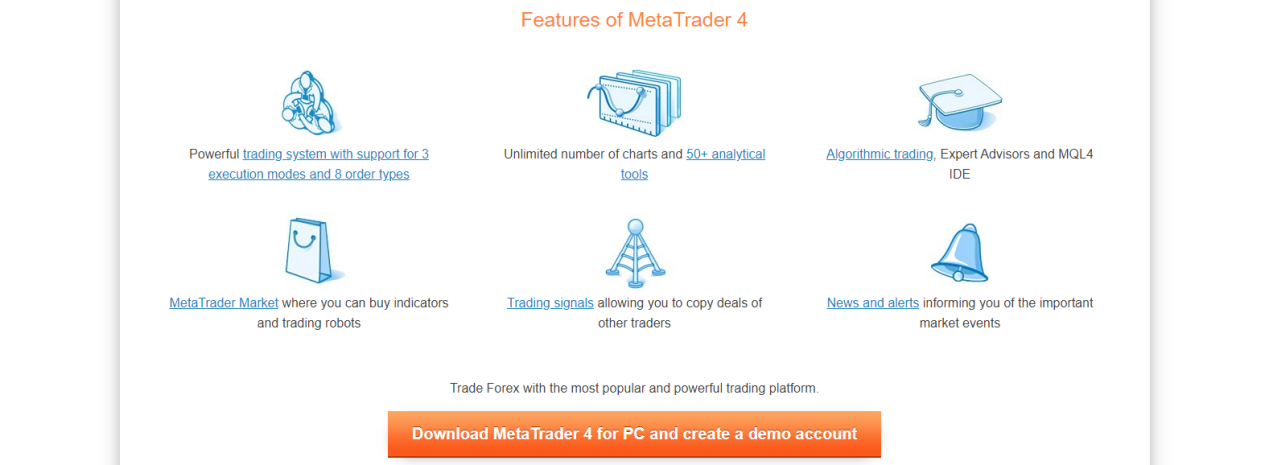
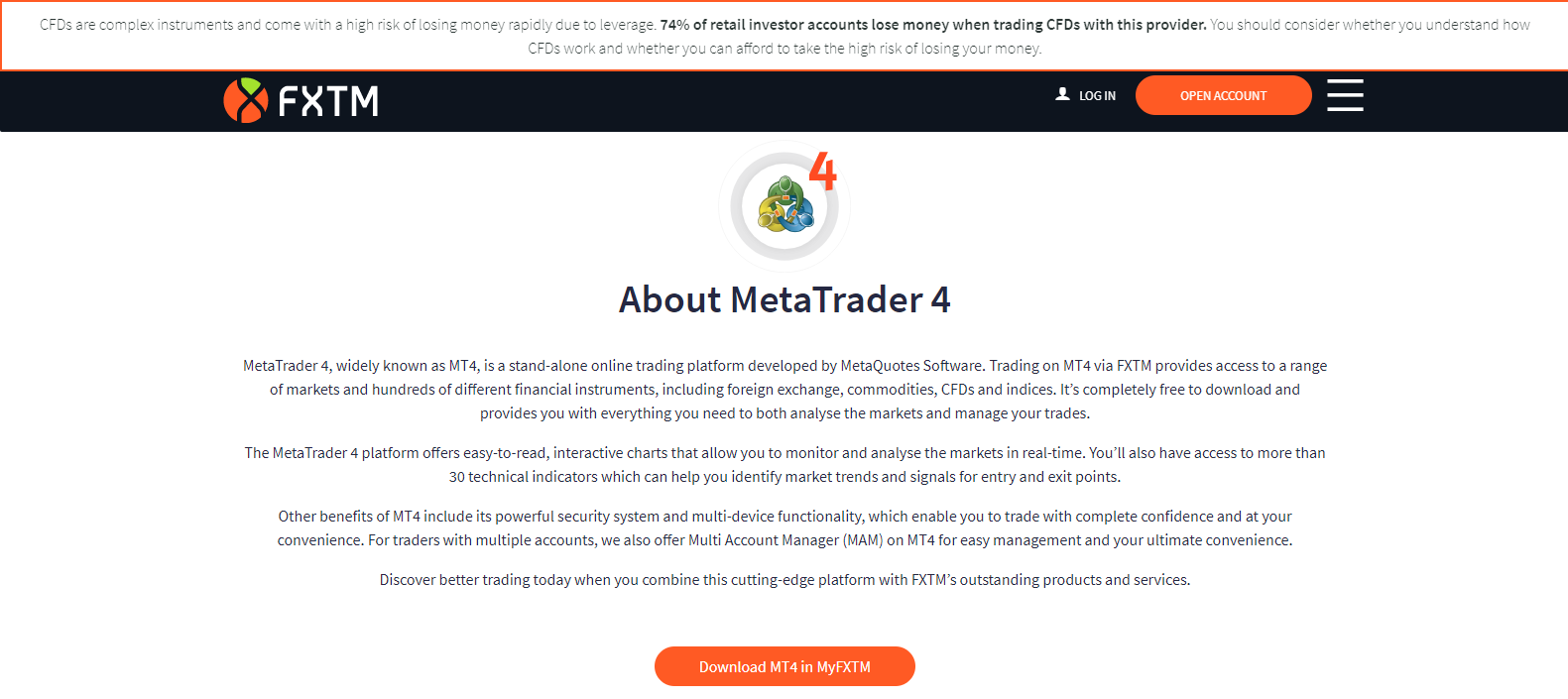
Installation and Set-Up of the MT4 Trading Platform
After downloading the MT4 trading platform, follow the easy installation instructions. You may click on Settings to change the destination folder and program group name. Once the installation is complete, click on Finish, and the MT4 trading platform will load automatically. Please note that if you have obtained your platform directly from your broker, you will receive an e-mail with your demo account number, password, and server to use.
After you finish the installation, the MT4 trading platform will load automatically. Select the demo server from the list and click Next.
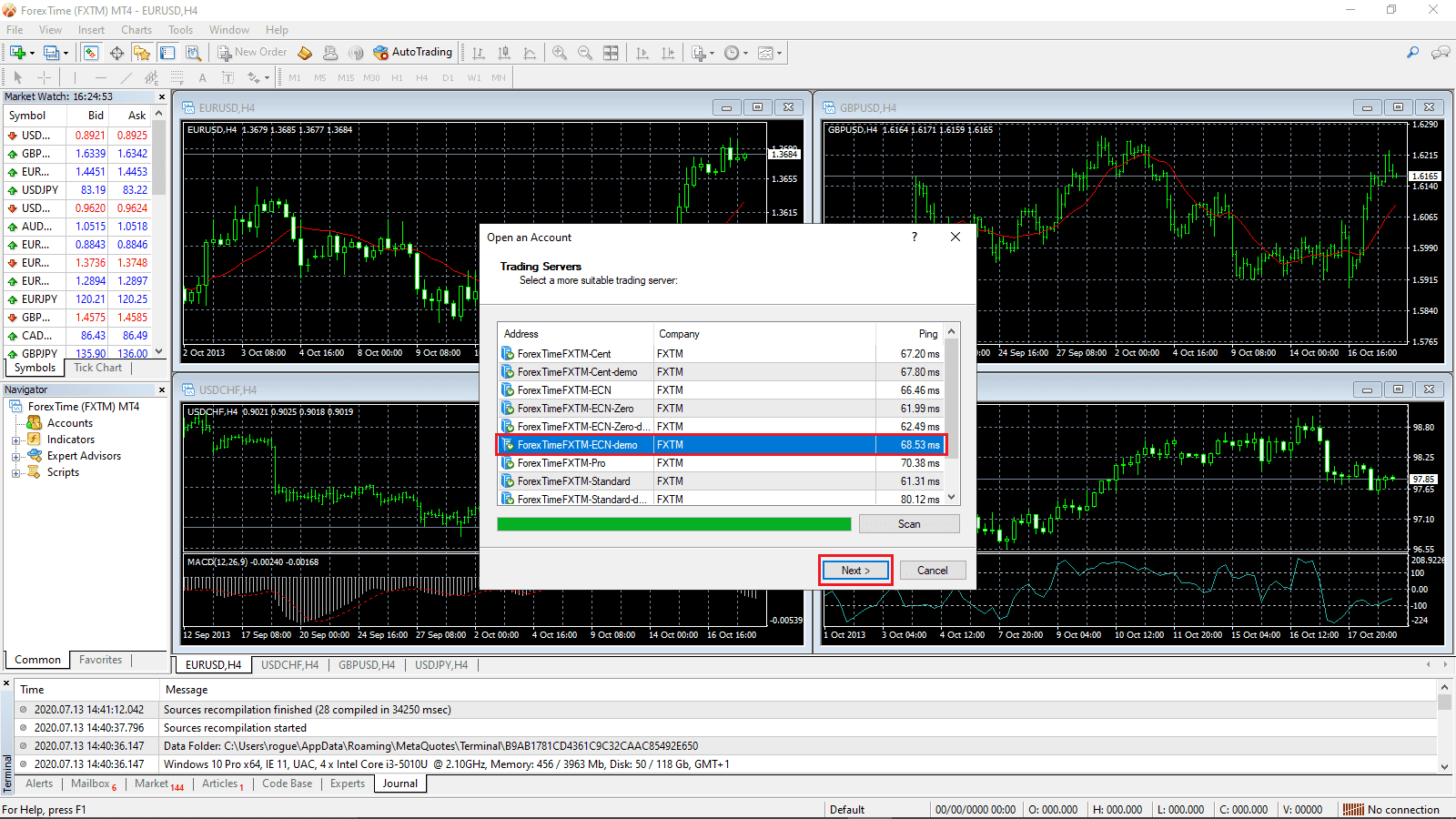
Enter your account credentials. Make sure to leave Save Password checked. That way, MT4 will remember your log-in credentials for the next time you launch it.
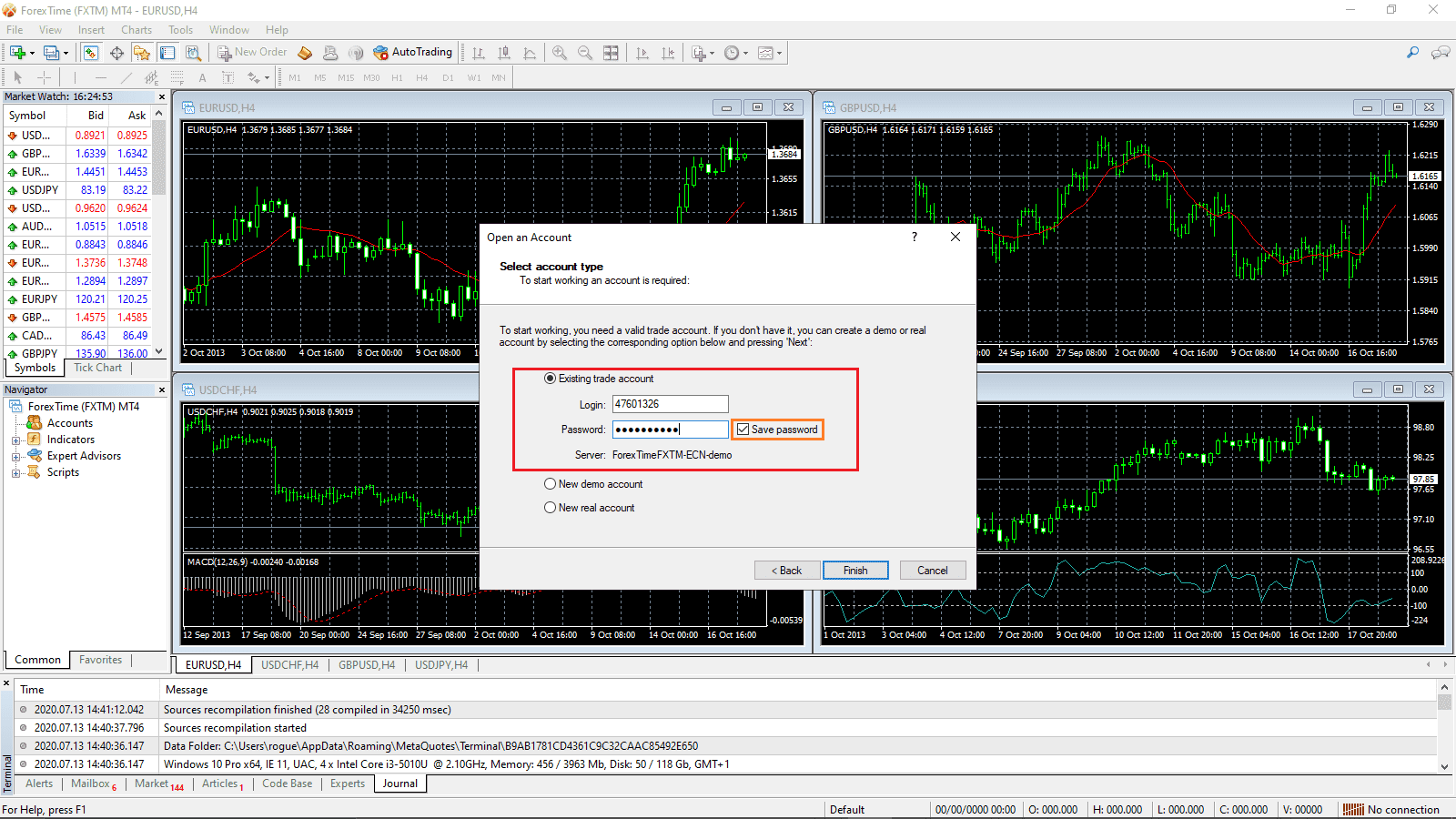
You are now ready to use your MT4 trading platform. While it may seem overwhelming at first sight, it is easy to use the product, as we will discuss below. It consists of six distinct sections, which we marked by different color rectangles. They consist of the Menu (red), the Toolbar (orange), Market Watch (green), Navigator (blue), Terminal (purple), and Chart Workspace (yellow).
The MT4 platform consists of six distinct sections.

MT4 Platform Sections
1. The Menu (red)
- All MT4 actions are available from here, but we will discuss the more trader-friendly options in this MetaTrader 4 demo tutorial.
2. The Toolbar (orange)
- Some of the most used functions, including changing the timeframe, primary technical tools, zooming, and changing the chart appearance, are located here.
3. Market Watch (green)
- All available assets are listed here. You can also switch to display a tick chart. Customizing which assets to show is also possible. Right-clicking on an asset and navigating to Specifications will display all details, including swap rates charged on overnight positions. Many brokers fail to mention it, and it remains one of the least used tools in MT4.
4. The Navigator (blue)
- Besides your account information, you have access to indicators, installed EAs, and scripts.
5. The Terminal (purple)
- Trade, exposure, and account history display your portfolio and allow you to manage open positions. The News tab features streaming market-related articles and events. The Market is where you can browse third-party add-ons.
6. The Chart Workspace (yellow)
- Your primary workspace where you will conduct your technical analysis. It is fully customizable, and you can save your template.
Here are some steps you can take to boost your user experience. By default, the Toolbar comes in two rows. It consists of Standard and Charts in the first row, and Line Studies and Timeframes on the second row. You can reveal the names by right-clicking anywhere in the Toolbar. You can drag the bottom two and drop them on the same level as the first two, which increases the Chart Workspace.
Since you will work with just one account for now, you can go ahead and close the Navigator. You can always pull it back up by clicking the Navigator icon in the Toolbar. When you hover your mouse over them, their name appears. After you close it, you will notice the Market Watch will fill out space. The restricted asset list is expandable by right-clicking anywhere inside the market watch and select Show All. Finally, click on Trade in the Terminal to see your account balance. It is also where all our open trades will be displayed.
Once you have completed these steps, this is how your MT4 trading terminal should look:
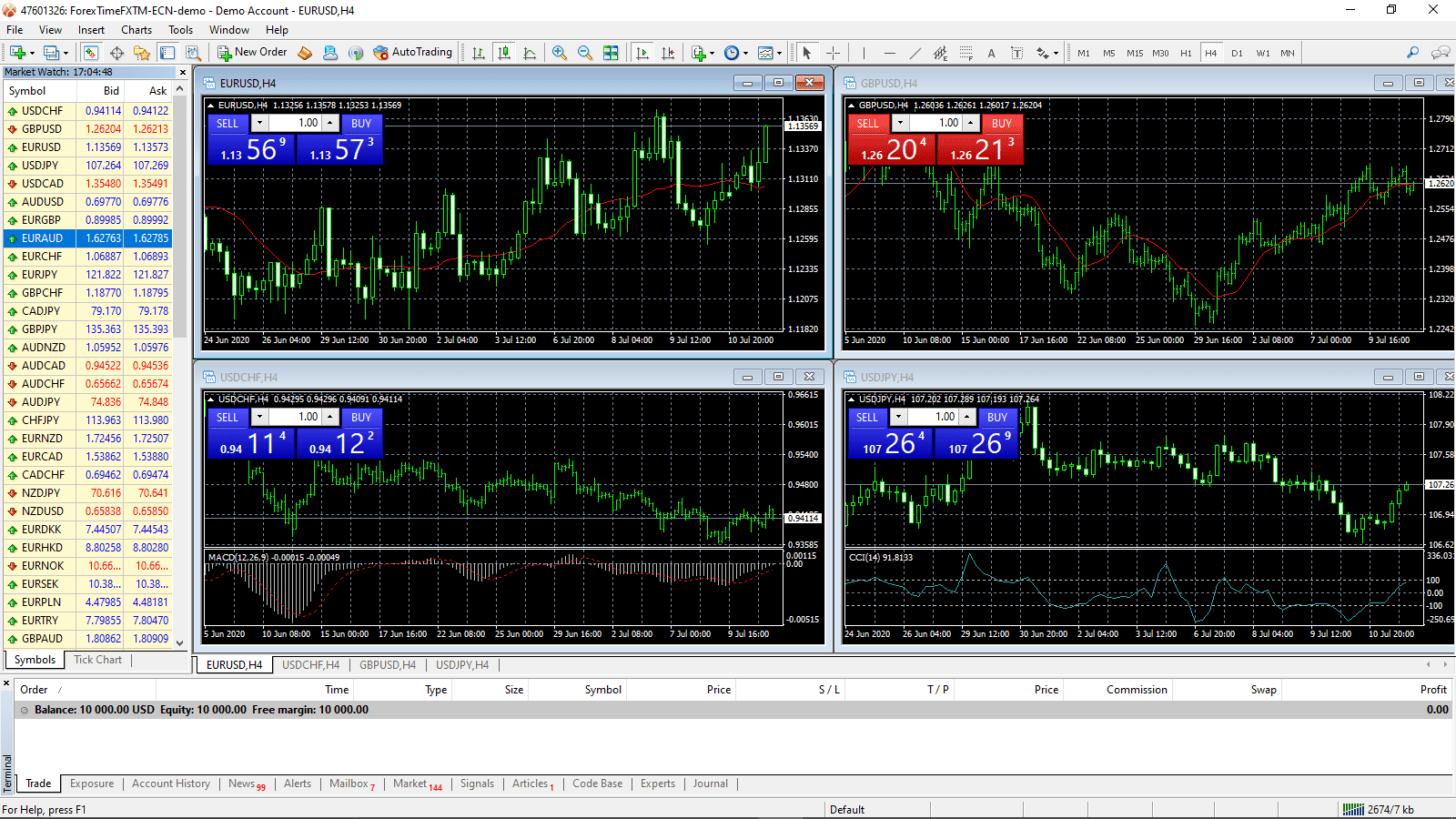
How to Trade on MetaTrader 4 with Charts
Charts are where you will spend most of your time in the MT4 trading terminal. By default, MT4 displays four, but as a new trader, it is best to start with just one. You can maximize the chart or arrange multiple ones as tiles by clicking on the corresponding Toolbar button. Opening a new chart is done by right-clicking on the asset in the Market Watch section, and then selecting Charts Window.
MT4 will automatically navigate to the new chart, which is also added to the bottom of the Chart Workspace window, as highlighted within the red rectangle in the below image:
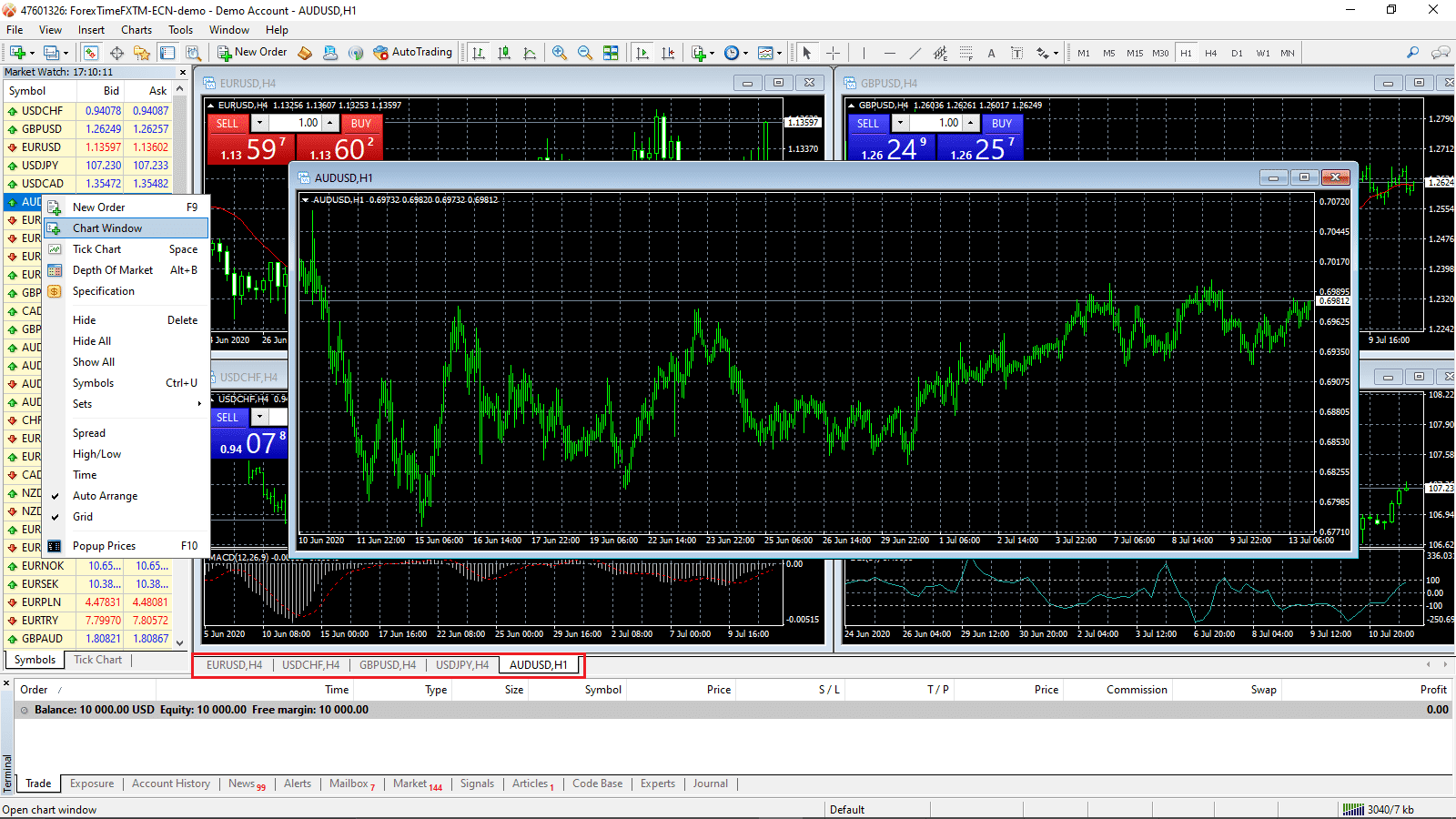
MT4 Two-Step Chart Layout Customization
Right-click within the chart and select Properties or press F8.
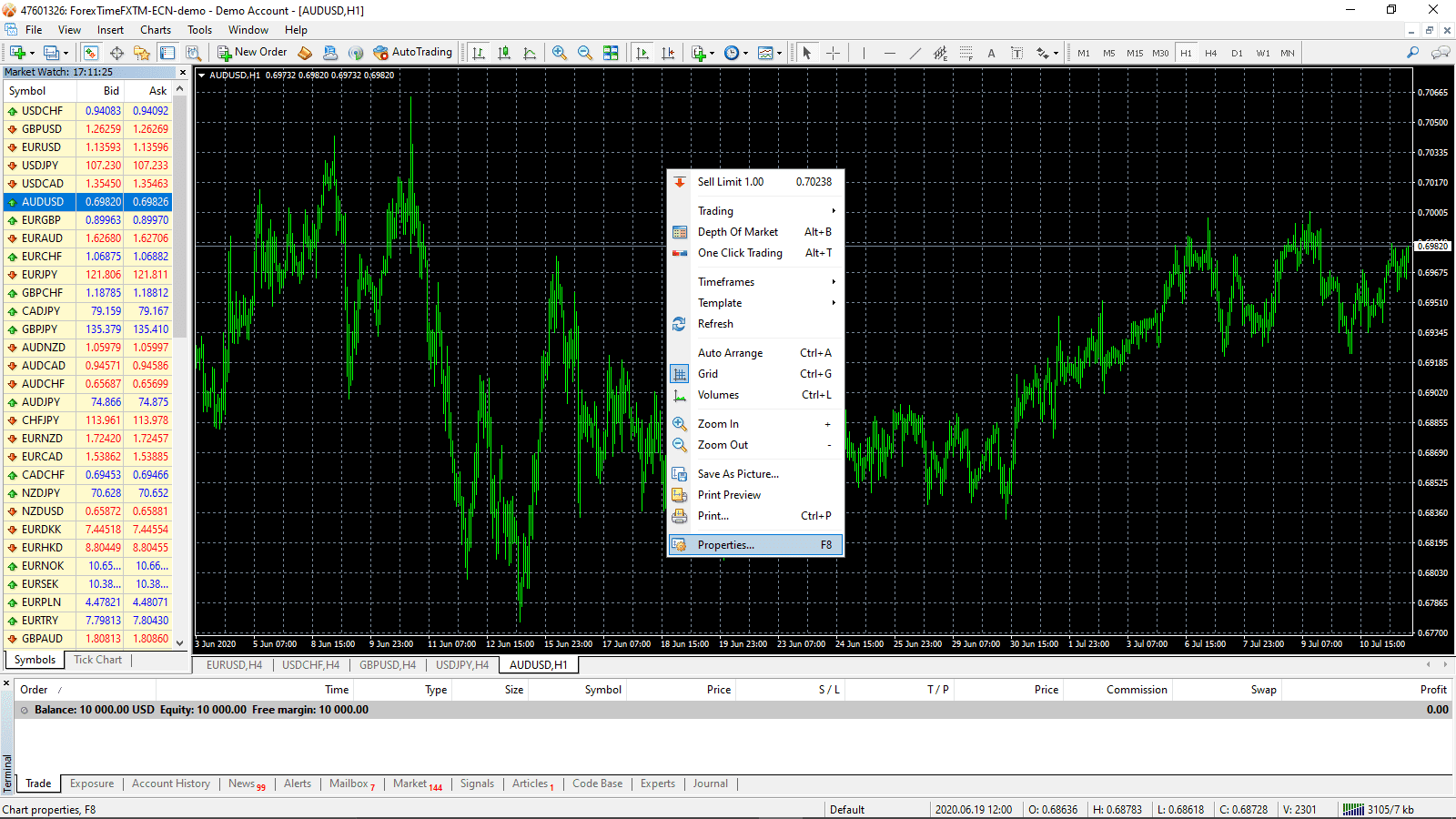
The property window consists of Colors and Common, where you can create the chart the way you want. Feel free to experiment with the options and find the style that suits you.
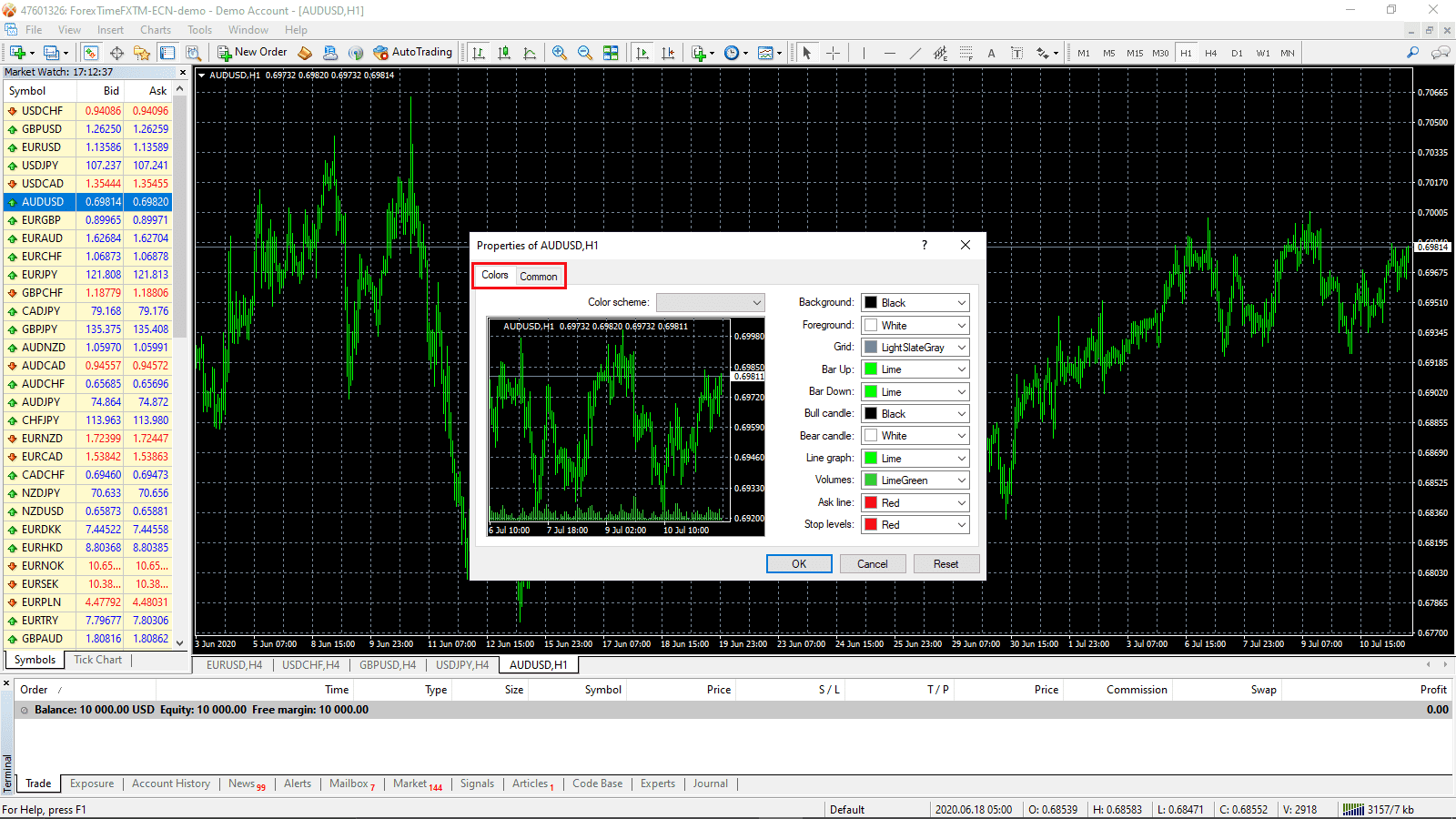
Below is the image of our customization that we will use for the rest of this tutorial. You can save it by right-clicking in the chart, select Template, and then on Save Template. Do not change the destination folder, name it, and you can now apply it anywhere you like. Just repeat the above steps you will see it listed.
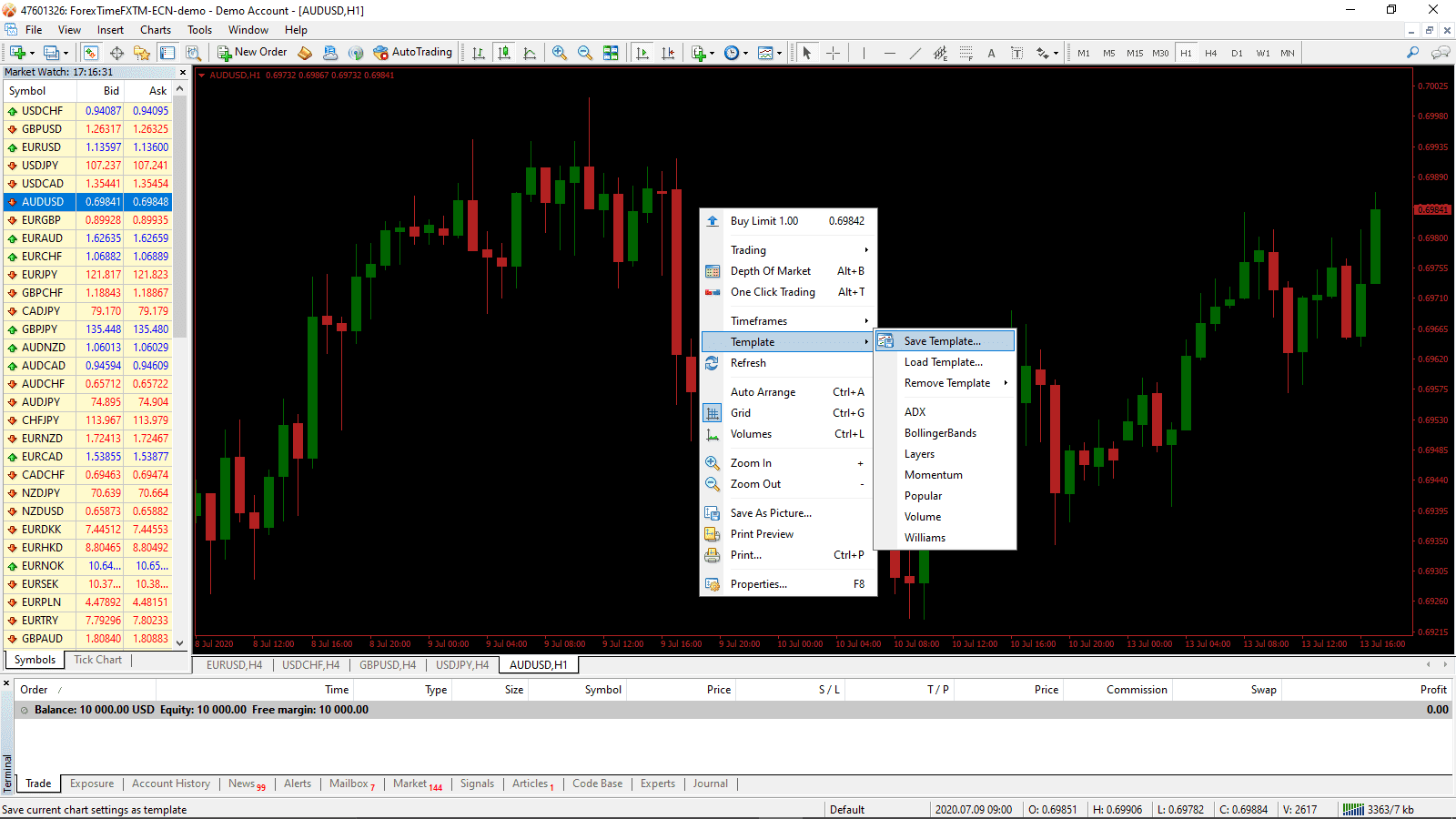
Bonus Tip: Saving your template with the name Default.tpl will automatically load it each time you open a new chart. You can always click Reset to restore MT4 settings to default.
MT4 Charts Tips and Tricks
When you work with charts in MT4, two essential items will ease your navigation and allow you to analyze assets more efficiently. They are the Toolbar and hotkeys.
Charts, Line Studies, and Timeframes allow you to make quick adjustments as you analyze assets.

1. Charts (red)
- You can change the visual display, zoom, arrange, auto-scroll, and shift, access the indicators list, select timeframes, and manage your templates from here.
2. Line Studies (green)
- The cursor is the default selection, but you can switch to the crosshair, which allows you to measure the distance between two chart points. Select the crosshair icon, then left click to identify the starting point. Keep the left mouse button pressed and highlight the endpoint. You will see the number of candlesticks, distance in pips, and last value. Line studies also allow you to draw vertical, horizontal, and trend lines, adding equidistant channels and the Fibonacci Retracement sequence, labeling the chart, and adding arrows.
3. Timeframes (orange)
- Nine are available, and you can cycle through them in ease. MT4 allows you to load different ones on each chart.
Do not be afraid to experiment. The MT4 demo account exists so that you learn how to use the trading platform properly. You can always hover your mouse over the icons in the Toolbar, which will display their functionality together with the hotkey, if one is available. Hotkeys will help speed up navigation and modification of charts, and the more assets you analyze, the more you will learn to appreciate them.
Here is a list of hotkeys for your MT4 chart, taken directly from the MetaQuotes website:
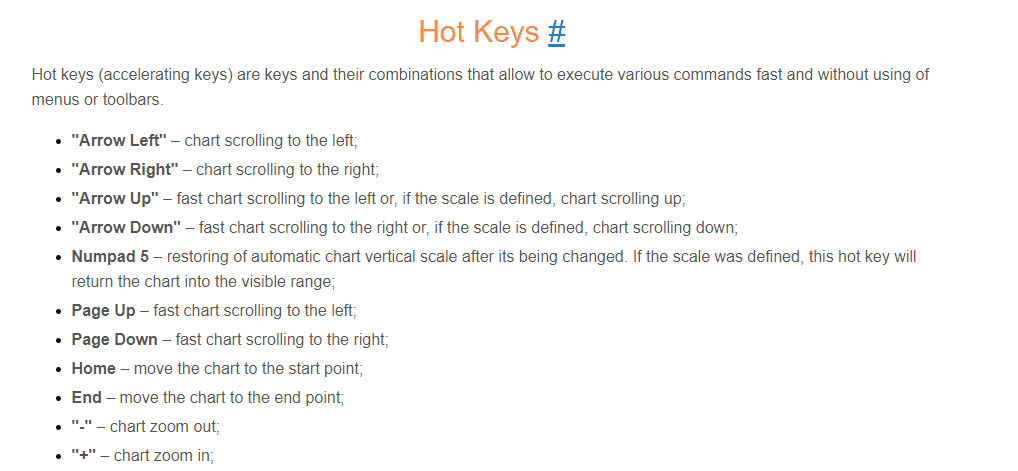
How to Trade on MetaTrader 4 with Indicators
Now we will take a look at how to analyze assets with indicators and how to place orders. You have a range of technical indicators you can use. Some are added inside the chart, while others are placed below it.
The quickest way to use indicators is by selecting Insert from the Menu. Alternatively, you can do so by using the Navigator, as marked by the red rectangle.
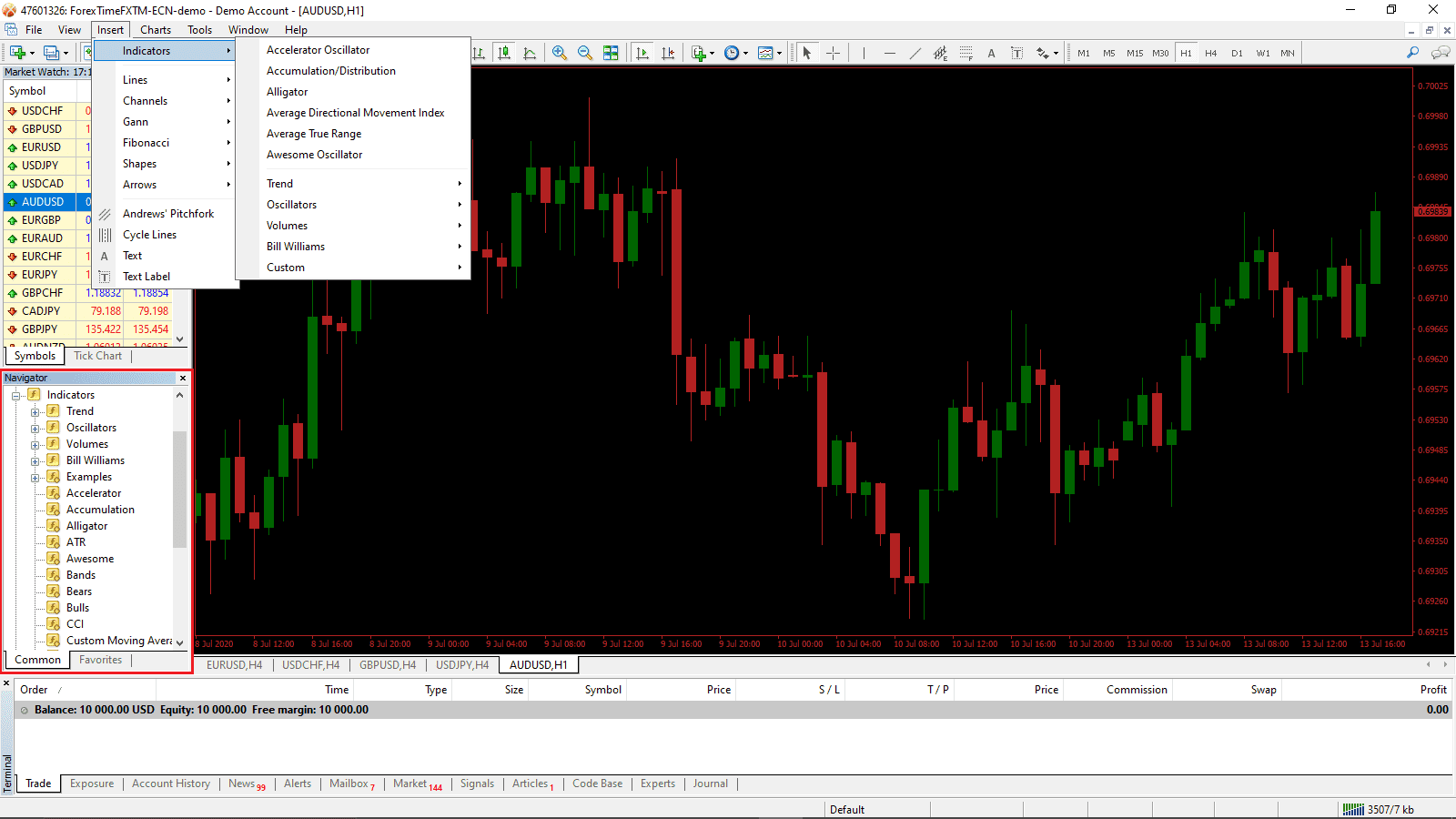
In this example, we will add the Commodity Channel Index.
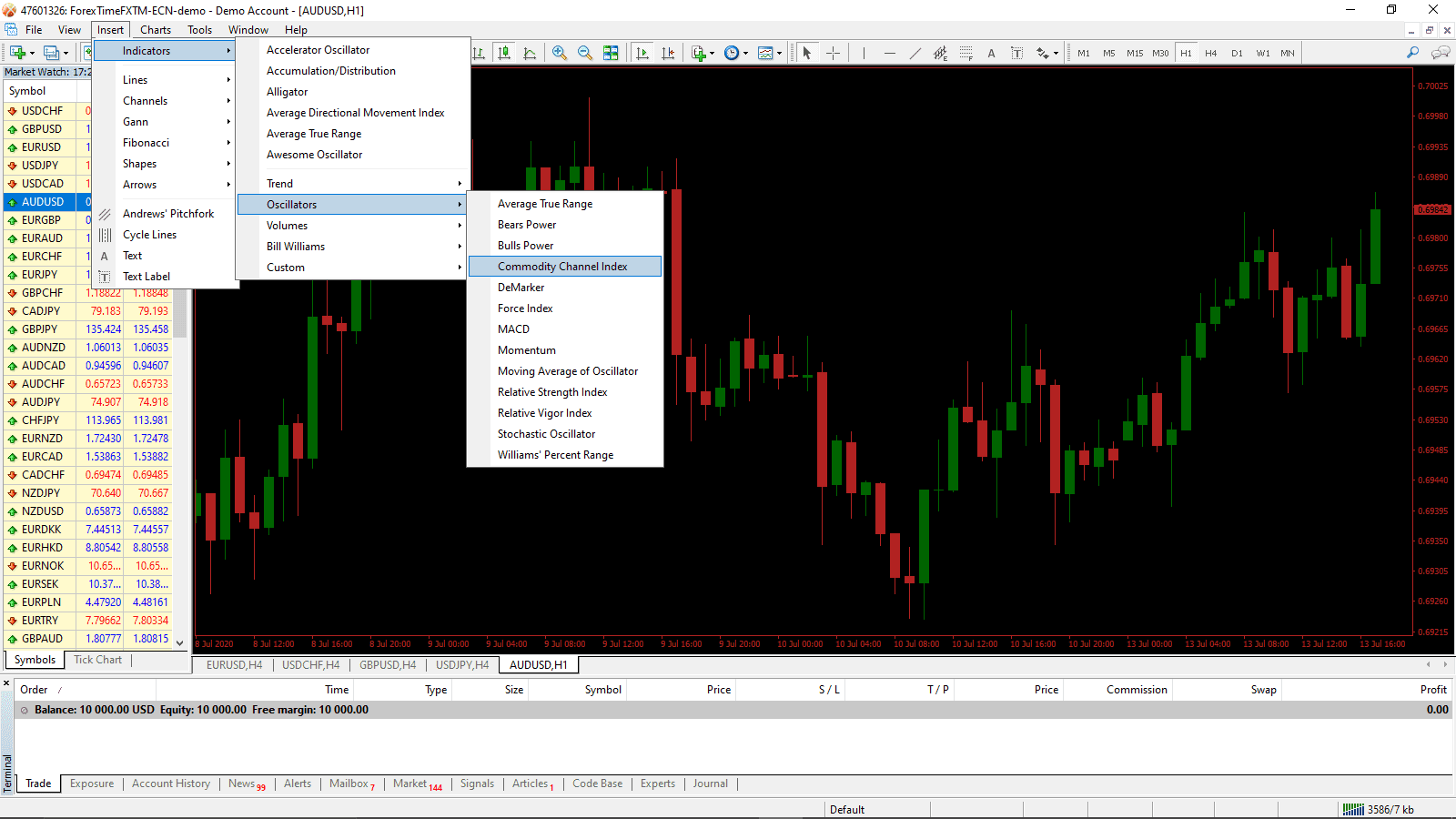
Each indicator consists of settings, visible in the dialogue box after you select the one to add. Clicking OK adds the indicator to your chart.
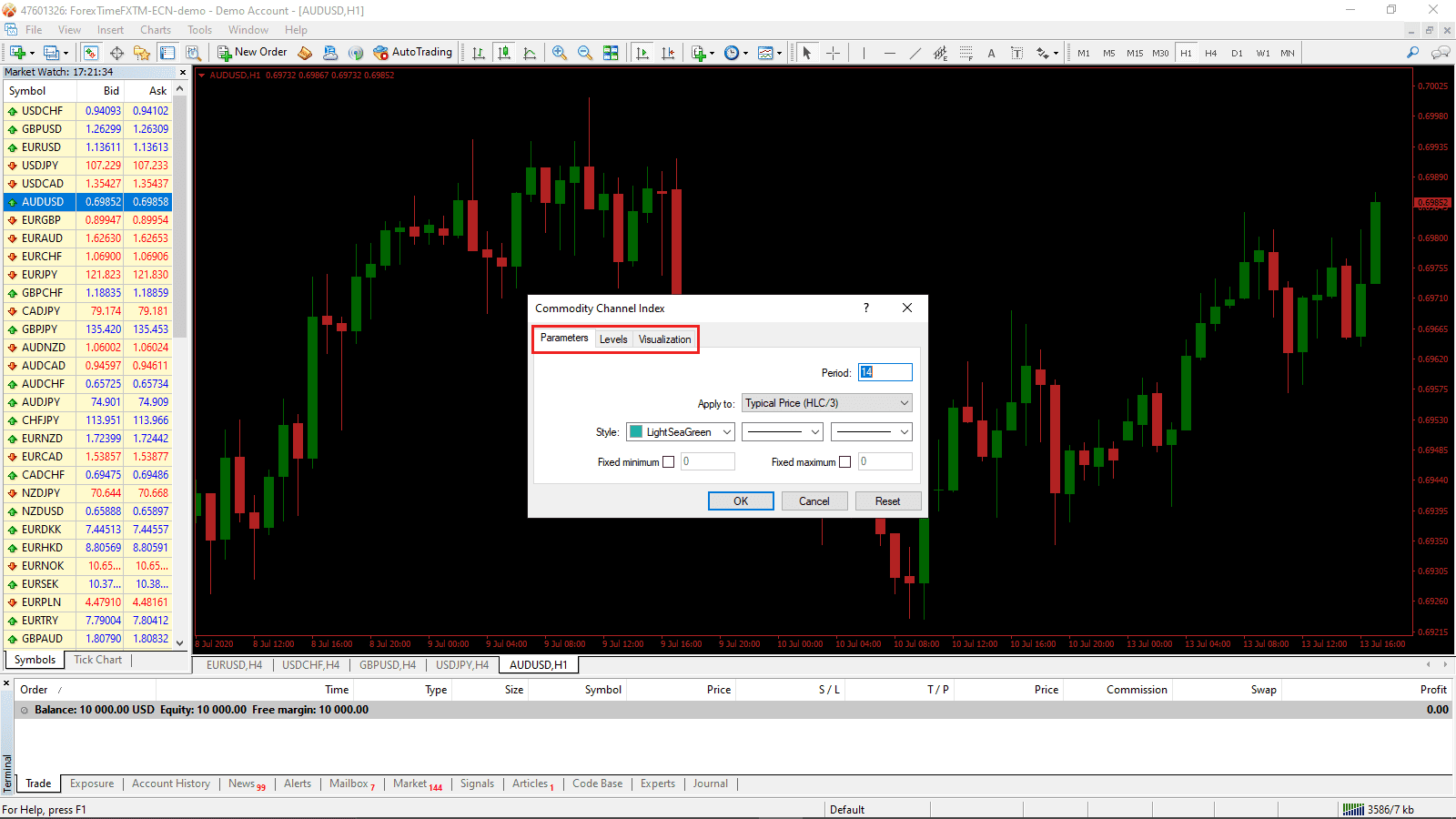
We have also drawn the Fibonacci Retracement Fan sequence, by using the corresponding icon from the Toolbar and added a Simple Moving Average indicator.
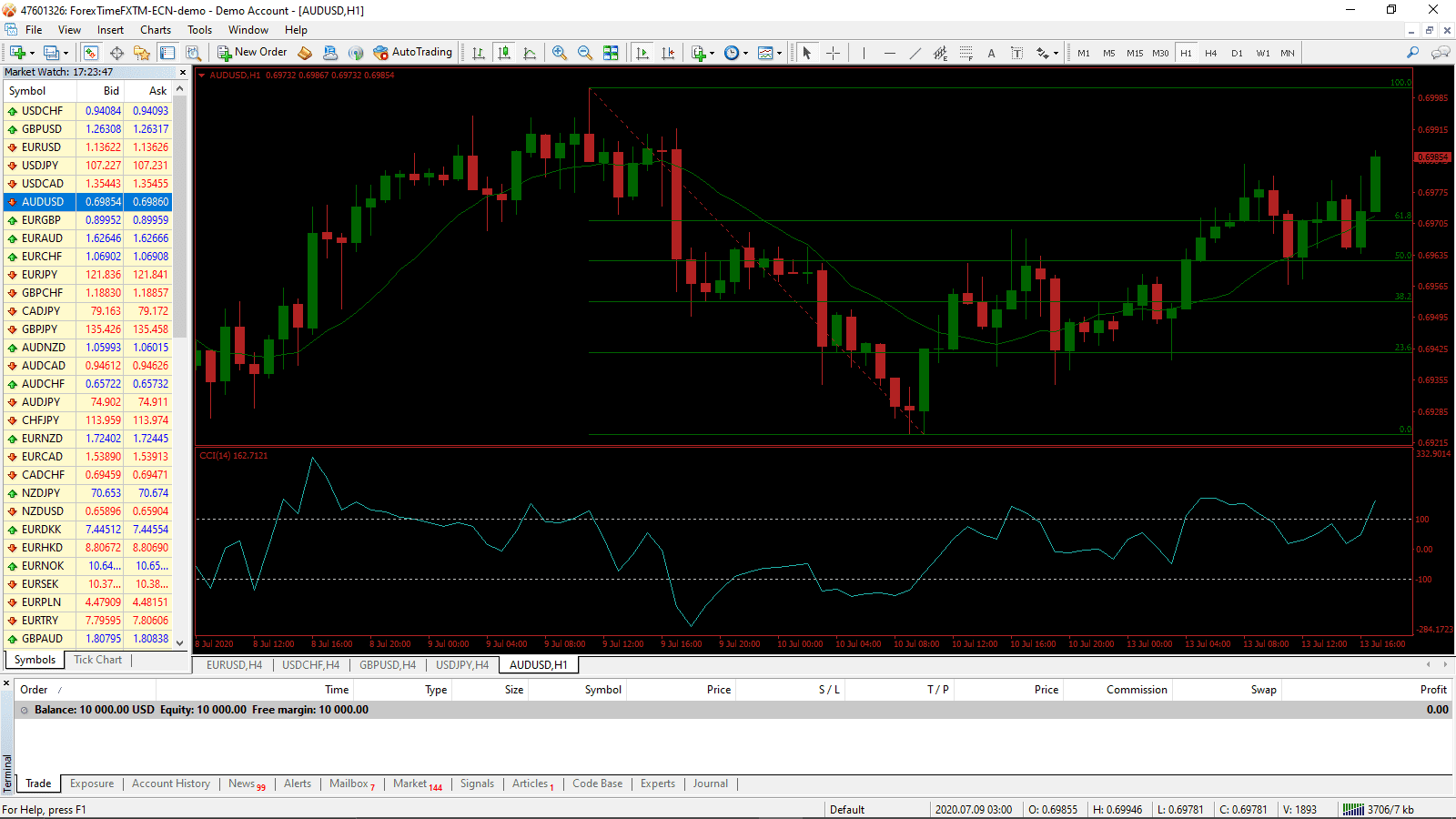
You can always delete an indicator by right-clicking on it, which brings up the box shown in the image below:
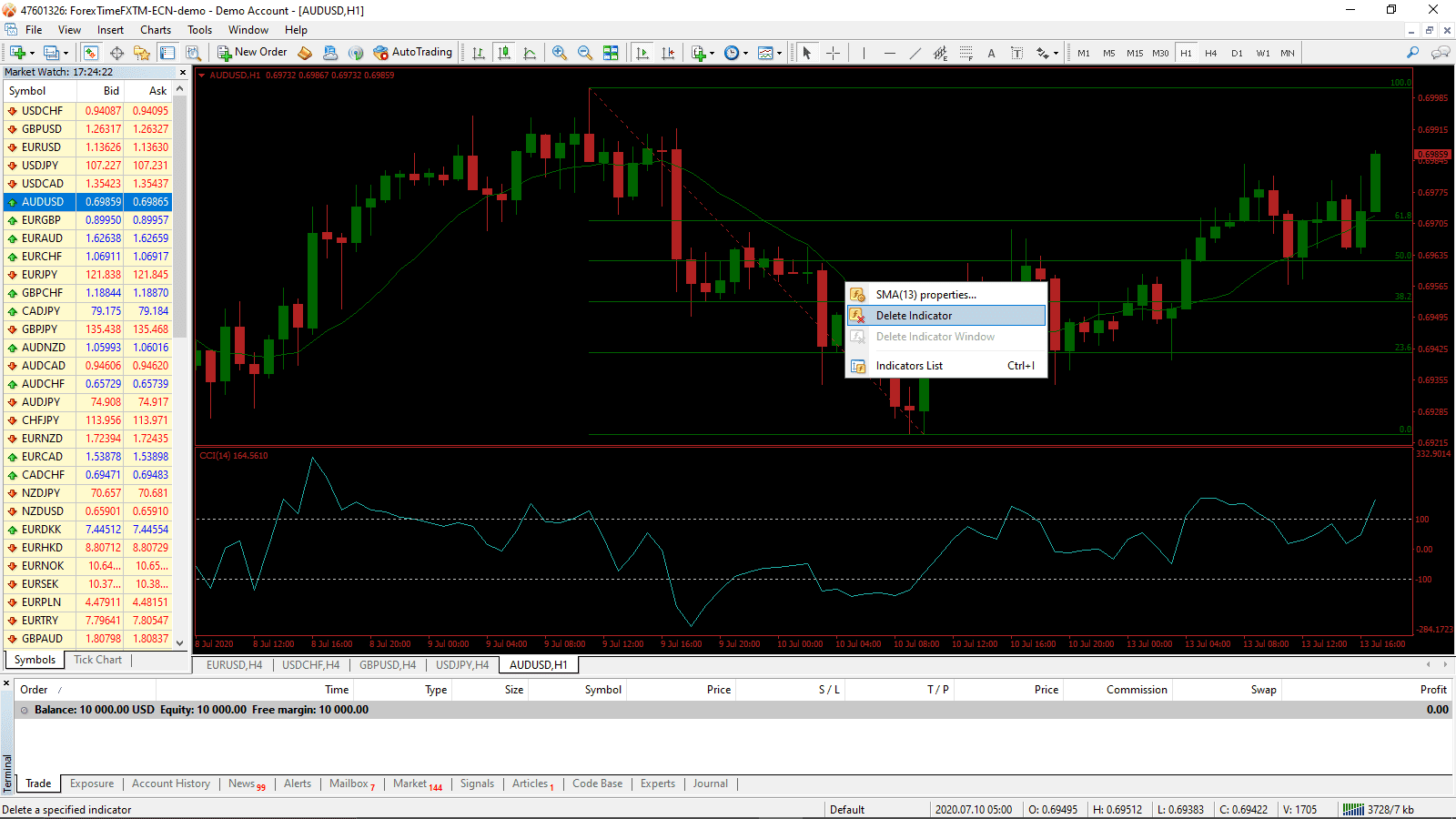
Bonus Tip: Create one template with all the indicators you wish to use, so you don’t have to add them to each chart. You can easily manage objects by pressing CTRL + B, which pulls up the Object List.
Placing Trade Orders in MT4
Placing trade orders is simple and straightforward, with four available order options. Market order placement is most convenient through the one-click trading option, while the order window allows for more options and advanced strategies.
You can place orders either by right-clicking in Market Watch on your desired asset, by clicking the New Order icon in the Toolbar (red rectangle) or by pressing F9. One-click trading is enabled by clicking in the triangle next to the asset name (orange square).

The two differences between placing a market order via the one-click trading button and the order window are that in the order window, you can set a stop loss and take profit and add a comment.
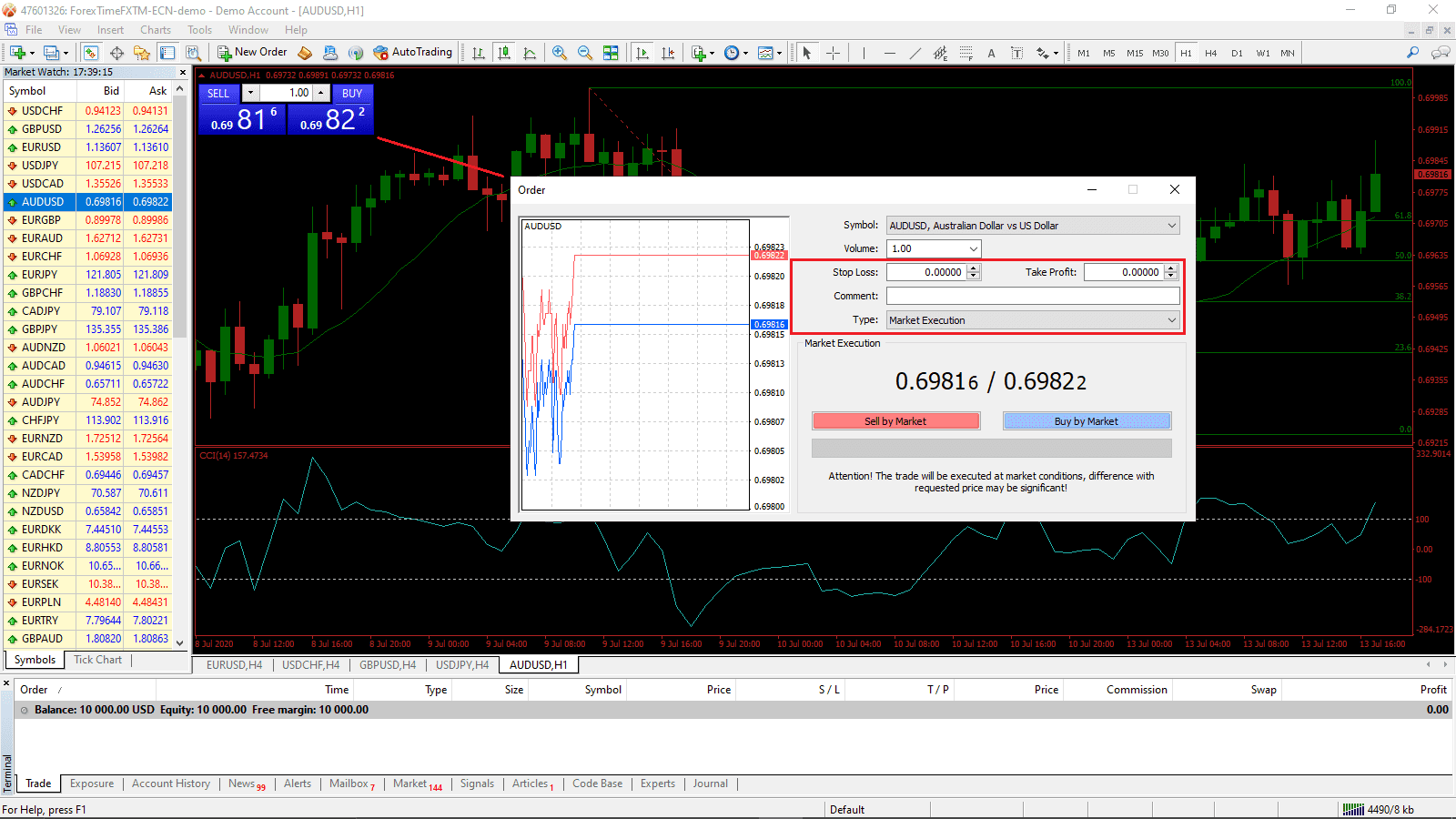
You can place pending orders by changing the Type (red). You will notice a change in the order window, which allows you to select the order type and price level (orange). After clicking on Place, your pending order will appear in the Terminal (green), you can always delete it by clicking the x button (blue). Since the market moved fast, our pending order was already triggered.
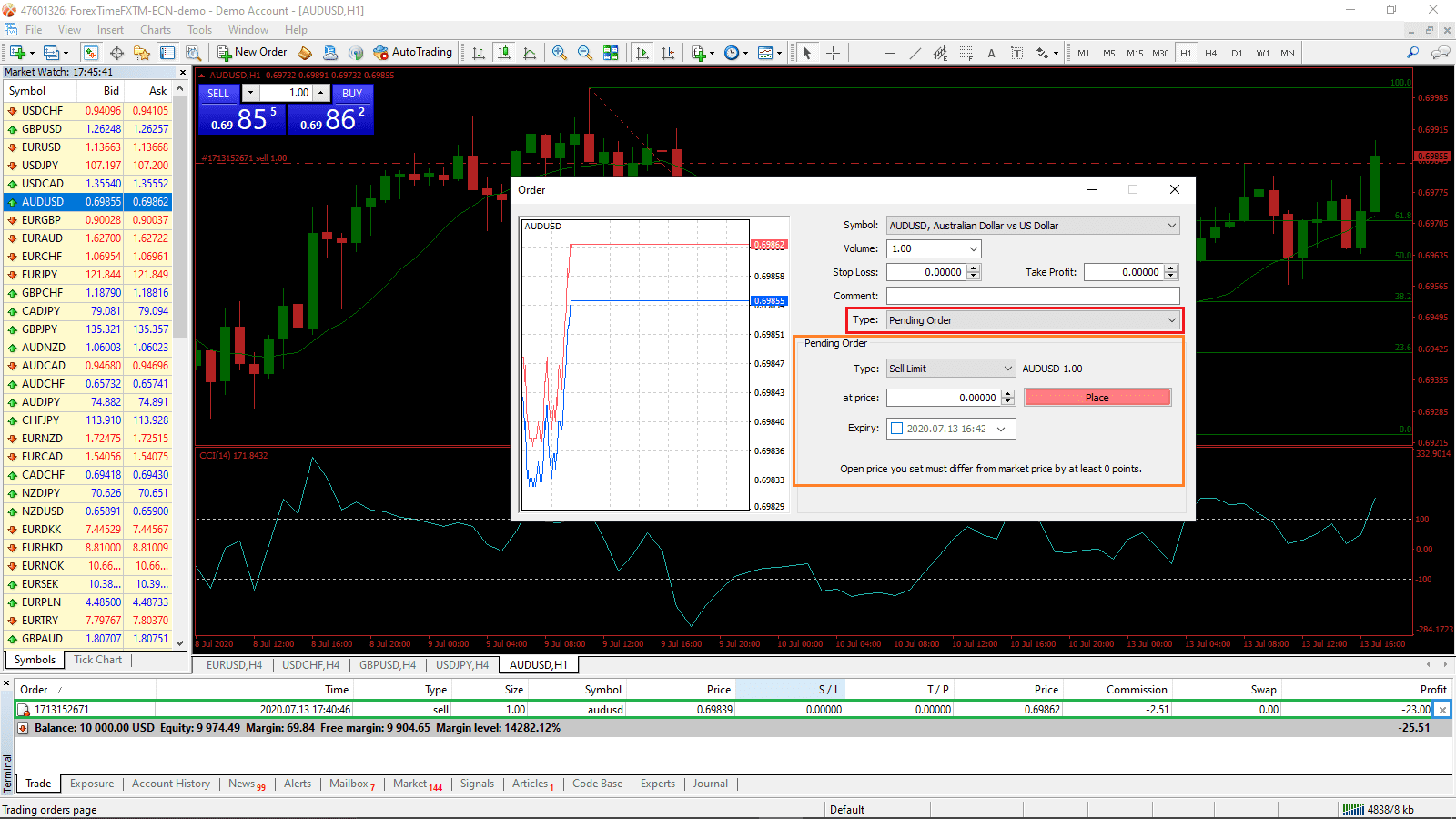
Here is an explanation of the four pending order types directly from the MetaQuotes website:
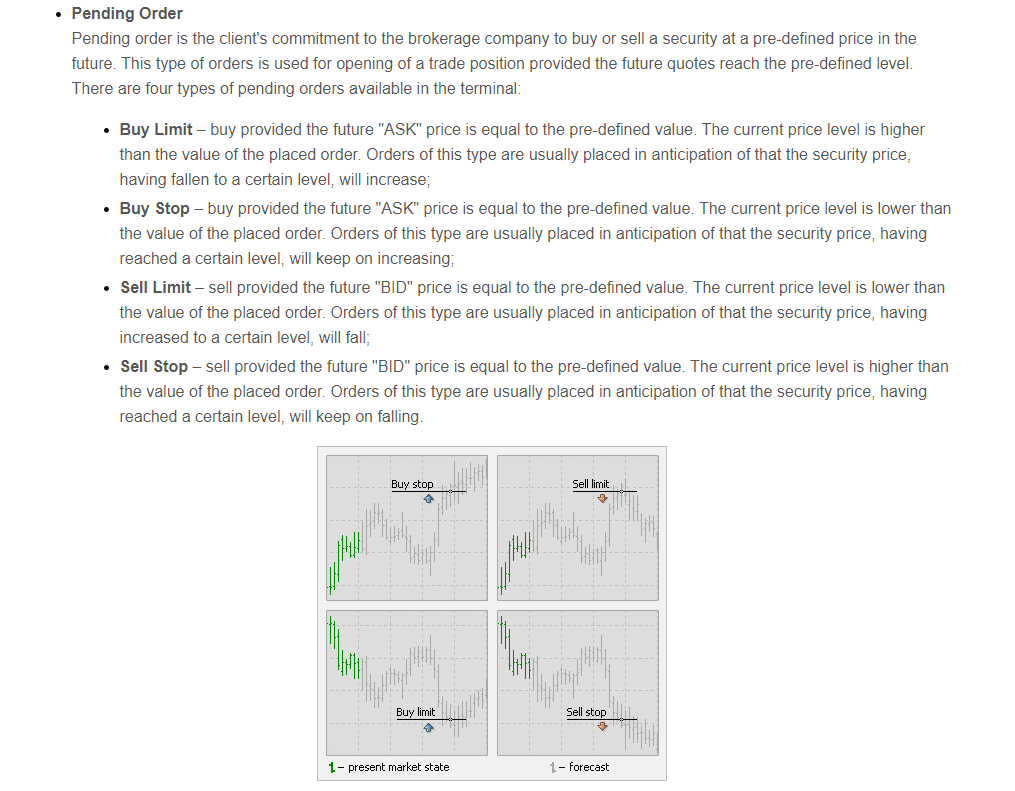
After you place a market order, you will receive a confirmation, and the position is then displayed within the Terminal (red rectangle).
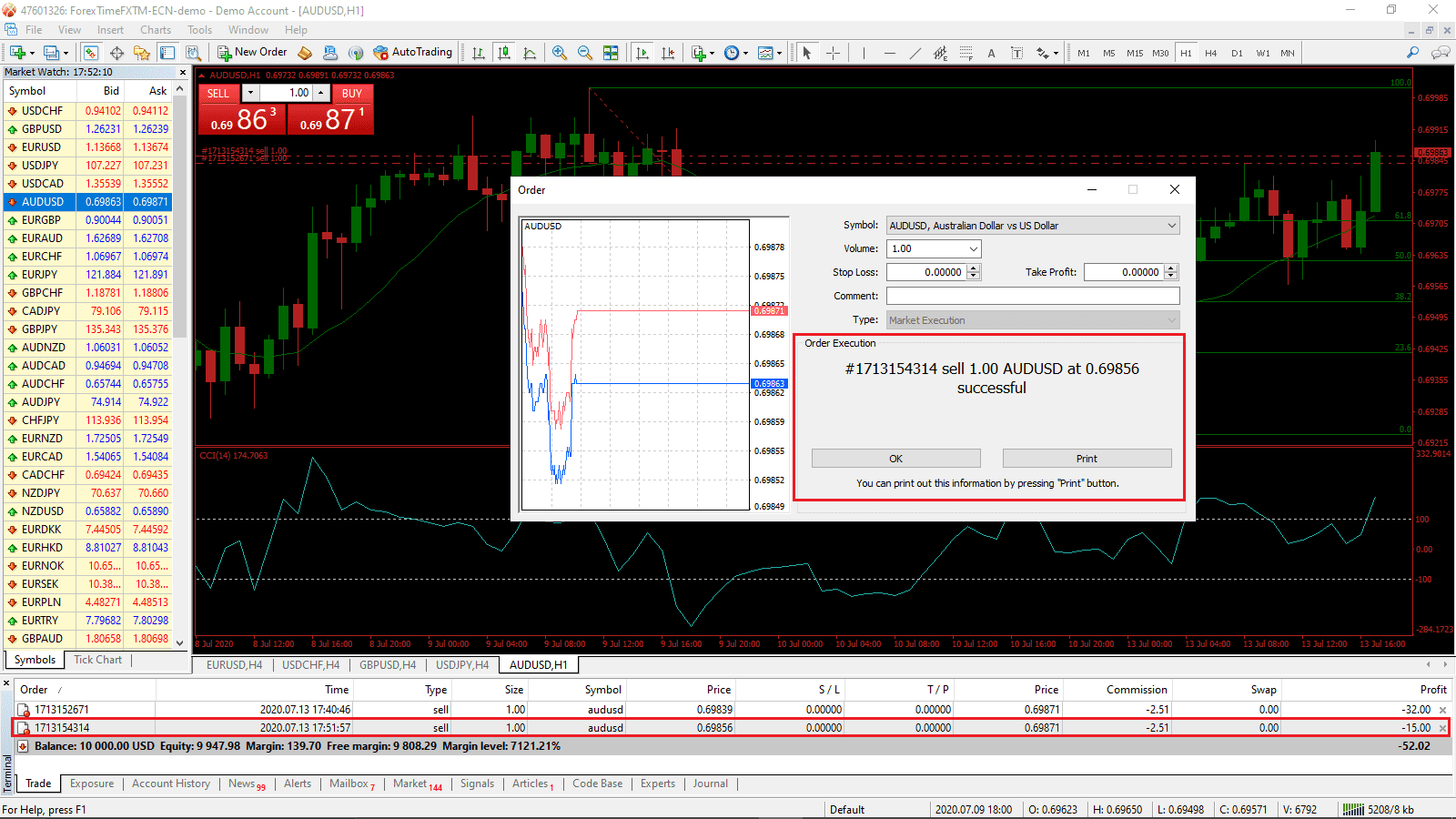
MT4 Portfolio Management
Portfolio management is an essential part of your daily trading operations. It is conducted primarily from the Terminal from the Trade and Account History tab. The Exposure tab is flawed as it always considers your account currency as part of the calculations, and there are third-party add-ons for precise portfolio exposure statistics.
You may close open trades by clicking on the x button (red rectangle). The first time you do so, a confirmation dialogue requires confirmation (orange rectangle).
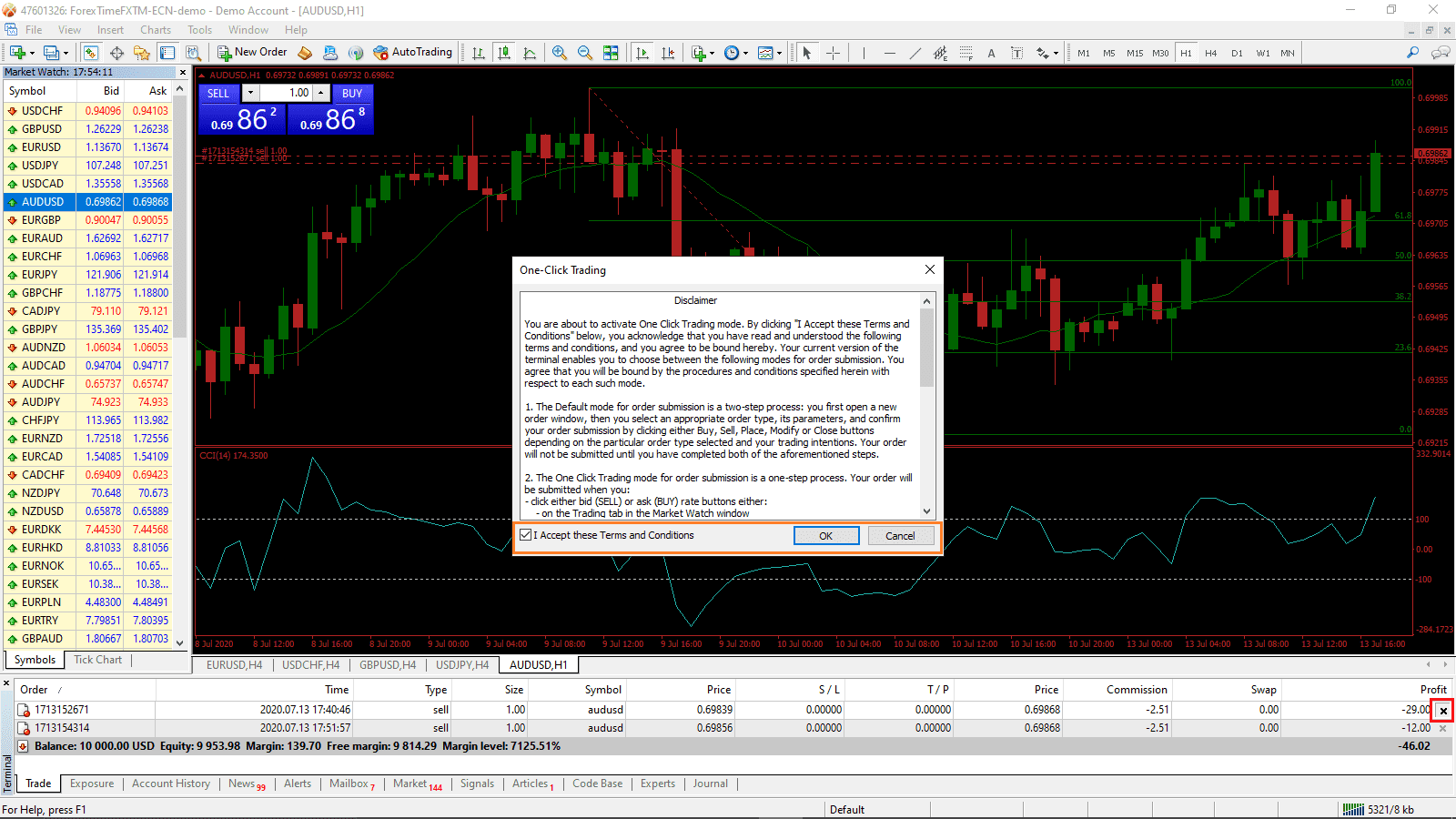
Open positions can also be modified. Double-click on the desired order in the Terminal and the order window will appear. Under Type, select Modify Order (red). You can now adjust your open order (orange) by adding a stop loss and take profit, either by setting the price or by selecting the distance in pips under Level, then press Copy as, and finally, Modify.
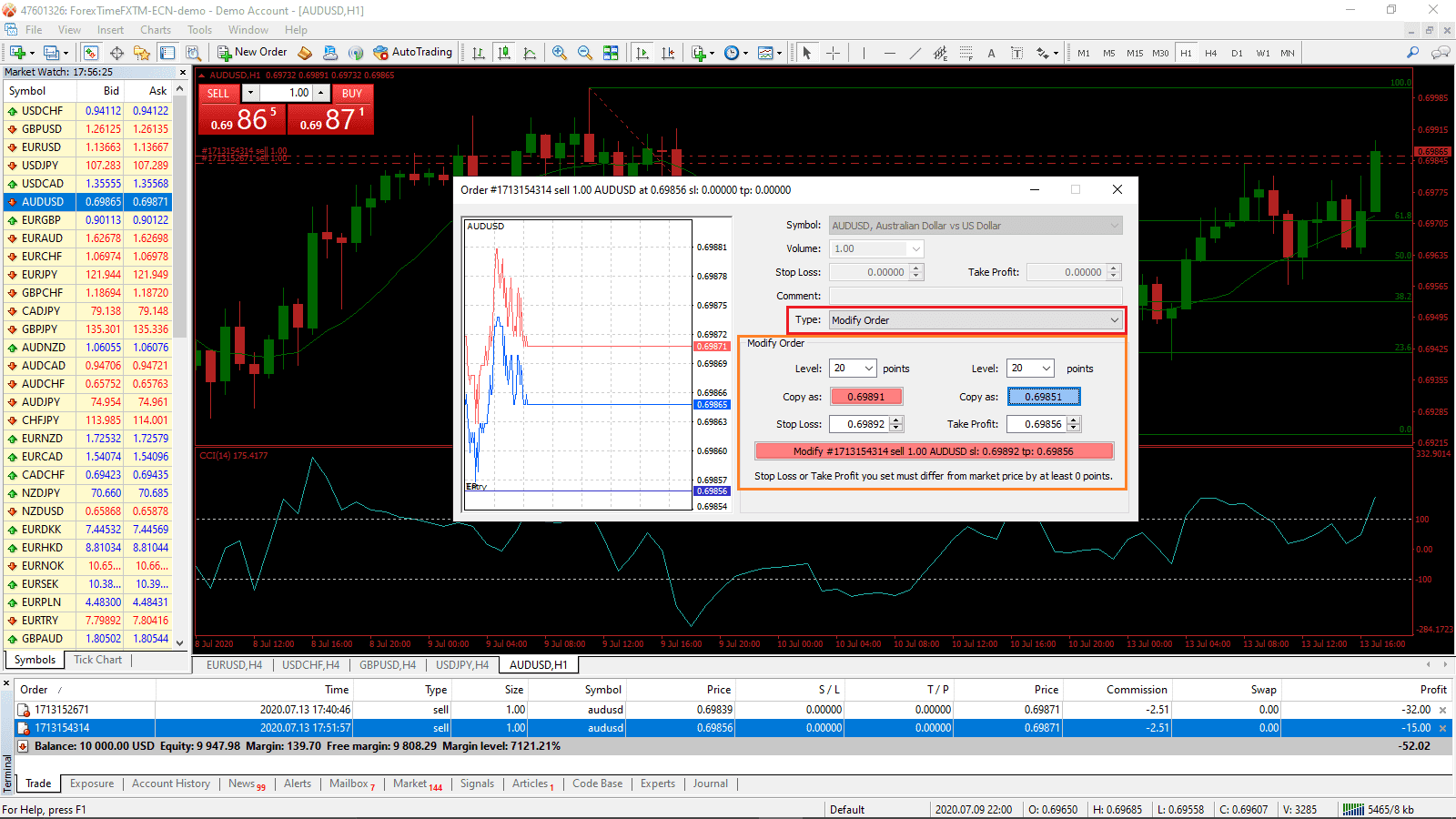
You can see the stop loss and take profit levels were updated (red rectangle).
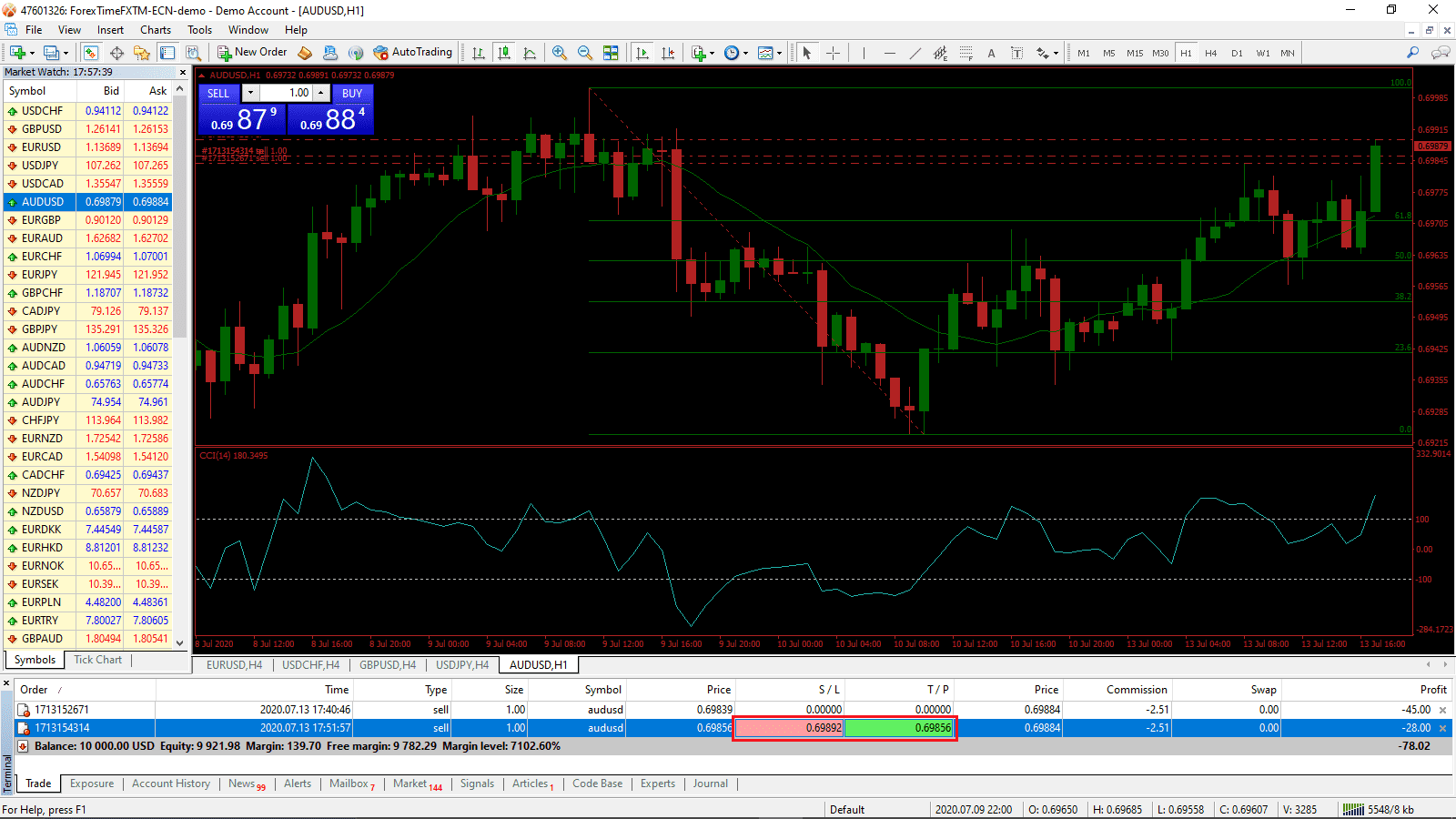
You can navigate to the Account History tab in the Terminal (red rectangle) and view details about your closed positions. As you can see, our open trade was closed. Manually exited positions are not colored. Trades closed by stop-loss and take profit are highlighted in red and green, respectively. It does not indicate the profitability of the closed position, which you can view under the Profit column.
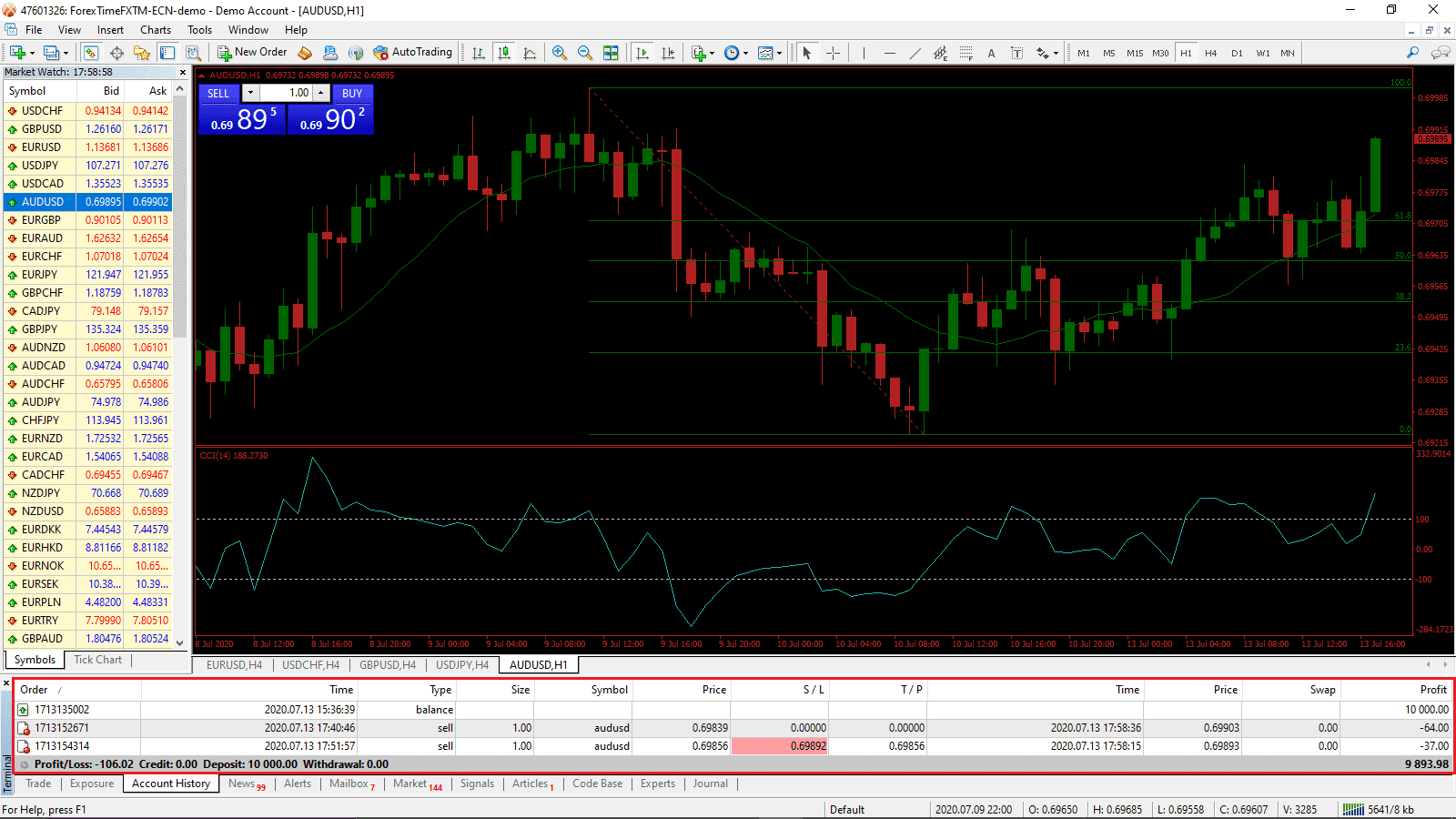
Final Thoughts
The MT4 trading platform is a simple but very effective trading terminal, as evident in its popularity despite its age. Do not be afraid to experiment in your demo account. You can always refer back to this MetaTrader 4 demo tutorial for assistance. You should understand how the trading platform functions before considering the MetaTrader 4 open real account option. Progress at your own pace, do not rush the learning process and proceed with a live trading account after you feel comfortable with using the trading platform.
MT4 is a very versatile gateway to analyzing assets, with a focus on the Forex market. Once you have learned the basic functionality of it, you can enhance it by upgrading it through third-party add-ons. Feel free to browse the Market, located in the Terminal, where thousands of free upgrades are available together with paid ones, to enhance the functionality of MT4 and turn it into a powerful asset management tool.
The MetaTrader 4 open real account option is available by clicking on File and then on Open an Account.

